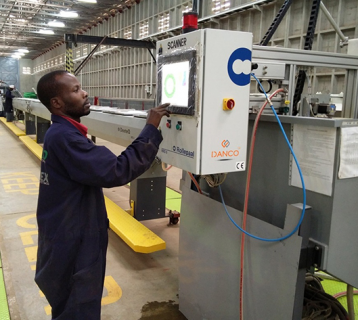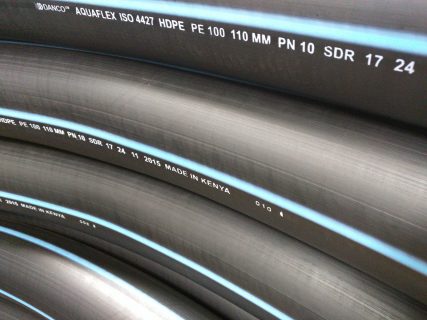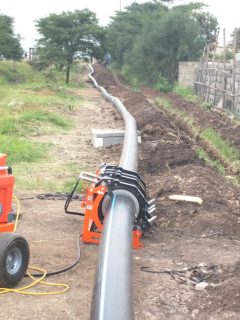Introduction
Danco is a pioneering manufacturer of high quality large diameter HDPE, PP-R and suppliers of UPVC pipe systems. Based in Kenya, Danco is part of the Spinners group of companies with manufacturing experience that extends back 40 years. Danco encompasses a unique approach, incorporating some of the best manufacturing practices, systems and policies, together with the latest, state-of-the-art manufacturing machinery obtained from the OEM’s in Europe and the United States.
 These steps, along with the partnerships that Danco has established with leading international vendors ensure that the company’s products comply with the highest quality standards and provide state of the art solutions for an ever growing market of water, gas and mining applications in East Africa. Danco’s partners include AVK valves (Denmark), DIEHL metering (Germany), UNIDELTA pipe fittings (Italy) and Huerner Butt fusion equipment (Germany).
These steps, along with the partnerships that Danco has established with leading international vendors ensure that the company’s products comply with the highest quality standards and provide state of the art solutions for an ever growing market of water, gas and mining applications in East Africa. Danco’s partners include AVK valves (Denmark), DIEHL metering (Germany), UNIDELTA pipe fittings (Italy) and Huerner Butt fusion equipment (Germany).
 Danco initially manufactured HDPE pipes of up to 400mm diameter, a first in the market where the norm was production of up to only 200mm. Following their latest expansion, the company now manufactures pipes of up to 630mm diameter with a strong focus on quality through their well-established Aquaflex brand.
Danco initially manufactured HDPE pipes of up to 400mm diameter, a first in the market where the norm was production of up to only 200mm. Following their latest expansion, the company now manufactures pipes of up to 630mm diameter with a strong focus on quality through their well-established Aquaflex brand.
The group, established in 1952, can look back on a successful story of growth and product development. Having supplied its products to distributors and prestigious projects, the company has grown to be one of the leading pipes manufacturers in the Sub-Saharan Africa construction industry.
HDPE Pipe Systems – Educating the Value Chain
High Density Polyethylene (HDPE) resins have a balance of properties that bring high levels of flexibility, strength and toughness to pipe systems. This has made HDPE the number one choice for water and gas distribution networks across the world.
HDPE lays claim to the lowest repair frequency per kilometer of pipeline when compared to other piping materials and is particularly suited for installing in challenging conditions, due to the combination of properties explained above. Danco has been at the forefront of the material’s increased use in Kenya through both education of end users and the successful installation of residential, infrastructure and commercial projects.
According to Dr. Suraj Dhanani, one of the directors of Danco, HDPE is a popular engineering material used in both developed and developing countries. The use of locally produced large diameter HDPE pipe systems was launched by Danco in 2014. Dr Dhanani states “Our aim is to promote the use of HDPE along with creating awareness of how to design, install and operate the pipe systems”. He explained that “Danco has a strong ethos with regards to promoting end user education throughout the value chain, in order to help reduce non-revenue water (a growing problem in Kenya) through the correct design and installation of HDPE pipe systems”.
 Danco currently has 10 teams of trained technicians to help its clients with the jointing of pipes and fittings to ISO standards. Dr. Dhanani emphasized that “We ensure quality standards in the manufacturing process and just as importantly, assist our clients in ensuring that the pipes and fittings are correctly installed”.
Danco currently has 10 teams of trained technicians to help its clients with the jointing of pipes and fittings to ISO standards. Dr. Dhanani emphasized that “We ensure quality standards in the manufacturing process and just as importantly, assist our clients in ensuring that the pipes and fittings are correctly installed”.
Danco Plastics works closely with HDPE resin material manufacturer Borouge, whose plant is located in at Ruwais in Abu Dhabi, which forms part of the United Arab Emirates. Dr. Suraj explained that the technical team from Borouge partner with Danco to organize regular workshops and seminars with the aim of educating end users about how they can implement high quality HDPE pipe network in Kenya.
According to Dr. Dhanani, the demand for corrosion free HDPE pipe systems is growing in East Africa due to the material’s excellent balance of properties including flexibility, use of welded joints, very low levels of leakage, easy installation and minimum 50 year design life. “Today, high-density polyethylene is the most cost-effective solution for piping in Africa. HDPE tackles a broad spectrum of piping challenges across the municipal, industrial, mining, and agricultural sectors,” he adds. “We are in this field for the long term and our vision is to provide end users with low maintenance networks that will help reduce water losses in all sectors across the region.”
Advantages of HDPE Pipe Systems
Low Life Cycle Cost
When end user organizations such as water utilities are considering which material their new pipelines should comprise, they need to take into account not just the cost of the capital (construction) cost, but the whole life cost of the network. This should take into consideration items such as the cost of operation, maintenance and repairs along with the value of water that may be lost through leakage (non-revenue water) and a realistic estimate of the operational lifetime.
Whilst HDPE pipes and fittings may have a little higher cost than those made of some other materials, the ability to fusion weld pipes and fittings together effectively eliminates the chance of leakage occurring at those joints. Because such joints are also fully self-restraining HDPE pipelines are effectively continuous, thereby eliminating the need for costly chambers, thrust restraints, anchor and thrust blocks. As Suraj explained, “The only purpose of a valve chamber on a HDPE pipeline is to keep the soil off the valve, it does not have to be designed to take any thrusts.” The polyethylene pipe industry conservatively estimates the service life for HDPE pipelines to be between 50 and 100 years, raising the potential of savings associated with pipeline replacement for generations to come. All these factors, along with lower pumping costs, due to the smooth pipe inner surface, contribute to a low life cycle cost.
Excellent Corrosion, Chemical and Abrasion Resistance
HDPE pipe systems will not rust, corrode or support biological scale or growth and have excellent chemical and abrasion resistance when compared to traditional pipe materials. These factors all contribute the HDPE pipe surface remaining smooth throughout its operational life. The above properties, when combined with high integrity fusion jointing make HDPE the material of choice for applications such as mining, dredging along with the transportation of slurries and aggressive chemicals such as corrosive acids, bases and salts.
Dr Dhanani emphasized however that these properties do not apply to all HDPE materials, but only those that comply with the international standards such as ISO 4427 and EN 12201. End users therefore need to take care when preparing engineering specifications and when it comes to the quality control of pipes and fittings employed on any project.
Resistance to Pressure Surges and Fatigue
Some engineers have expressed concerns about HDPE’s ability to resist pressure surges and repeated fluctuations in operational pressures, pointing out the strength of the material is less than that of steel for example. Dr. Dhanani explained that it is the materials durability, flexibility and ability to absorb rapid changes in pressure that have led to its adoption by many industries.
When pipes undergo 1 minute burst testing in accordance with the American ASTM standards the failure pressures are between 3 and 4½ the operational rating of the pipe system, hence design guides in Europe and the USA state that occasional pressure surges of twice the maximum operational pressure can be safely accommodated. The same publications explain that HDPE materials, which comply with the international standards, can accommodate millions of pressures variations during their lifetime with little or no effect.
Ease of Installation
The durability and flexibility of HDPE discussed above also allows materials to be gradually curved on site, so avoiding the use of bends in many cases, providing that the radius of the bend does not have to be tighter than 25 times the outside pipe diameter. Such properties, together with the light weight of the material, allow the pipes to be fusion welded together outside of the trench and then gradually ‘snaked’ in to the trench, so allowing trench widths and the volume of excavated soil to be minimized. Welding above ground also makes the jointing process much easier to undertake and supervise.
The flexibility of HDPE pipes makes them well-suited for use in poor quality and dynamic soils, whether these be in water logged areas or regions prone to earthquakes. Experience in countries such as Japan and New Zealand, which are prone to earthquakes, has led to the adoption of HDPE as the default water and gas network material.
Its combination of flexibility and fused joints has also made it the material of choice for trenchless installation techniques such as horizontal directional drilling (HDD), pipe bursting, slip lining and pipe plowing, along with being used for seawater intakes, outfalls and water channel crossings.
Black pre-compounded HDPE material, which complies with the international standards, contains well dispersed carbon black that provides complete protection against the effects of UV rays in sunlight. This means that that pipes can be stored in the sun or laid alongside the pipe trench for long periods of time with no adverse effects, even under the hot African sun.
Minimizing Environmental Impact
International studies have shown that HDPE pipe systems have a smaller environmental ‘footprint’ and hence less impact on the environment than pipes made of other systems such as ductile iron, steel and UPVC. This is down to the relatively low levels of energy required to produce both the HDPE material and the pipes themselves, along with the nature of the material and the long life time of HDPE pipe systems.
The use of significantly less intrusive trenchless technology techniques can be used to further reduce the environmental impact of HDPE pipe systems. In countries as far apart as the USA, the UK, India, Indonesia and China trenchless technology has gradually been gaining favor with utilities and their customers, as it is frequently quicker and has significantly less environmental impact than traditional open trench construction.
Interaction with the Value Chain and Client Services
The company maintains a long-standing rapport between themselves, their direct clients and other members of the value chain such as engineering consultants, utility operators and network owners. They achieve this by visiting construction sites during different project phases, providing project technical advice and undertaking a wide range of technical workshops and seminars, along with speaking at engineering events.
In line with this approach Dr Dhanani explained that Danco offer free training to the contractors before commencing any job on site. “We provide technical solutions from the design stage through to installation and commissioning, including standby teams to offer technical support on sites at short notice.” he went on to say that “Furthermore, when we undertake the jointing on site for our clients, the butt fusion machines we use collect the welding parameter data whilst undertaking the joints, enabling us to determine the joint integrity and so provide our clients with a warranty for each joint we undertake.”
Where to find Danco
We hope that this article has demonstrated why HDPE is the piping solution for the future and you can find Danco Plastics Ltd at their base in Ruiru town, behind Family Bank or through their website: www.dancoplastics.com


What’s the difference in the use of PPR and HDPE.